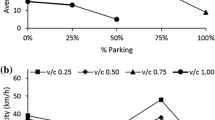Abstract
Queue jump lane (QJL) is a space-optimal facility-based priority measure to improve public transport operation at the intersection where the buses face a majority of the delay. This paper aims to design an implementation framework for QJL by focusing on the geometric specification of QJL and developing design strategy options for different scenarios of implementation. These strategy options have been designed after reviewing the different aspects of QJL, in combination with other elements, such as pre-signal, bus advance area, bus stop location, etc., which can bring effective results in terms of improving the bus travel time without significantly impacting the other vehicle users. After reviewing these strategies, different elements required for the implementation of QJL, such as road geometry, placement, and introduction of signages and road markings, etc., have been identified by studying the planning guidelines of dedicated bus lane/queue jump lanes followed in India as well as other countries. The implementation framework proposed in this work will be useful to practitioners who are interested to implement the queue jump lane as a bus priority measure in India in lieu of the existing practices of only providing dedicated bus lanes.
























Similar content being viewed by others
References
Arasan TV, Vedagiri P (2008) Bus priority on roads carrying heterogeneous traffic: a study using computer simulation. Eur J Transp Infrastruct Res. https://doi.org/10.18757/ejtir.2008.8.1.3329
Bhattacharyya K, Maitra B, Boltze M (2019) Implementation of bus priority with queue jump lane and pre-signal at urban intersections with mixed traffic operations: lessons learned? Transp Res Rec 2673(3):646–657
Bhattacharyya K, Maitra B, Boltze M (2020) Guidance for design and implementation of queue jump lane with presignal for a heterogeneous traffic environment. J Trans Eng Part A: Syst 146(10):04020111
Cesme B, Altun SZ, Lane B (2015) Queue jump lane, transit signal priority, and stop location evaluation of transit preferential treatments using microsimulation. Transp Res Rec 2533(1):3949
Prommaharaj P, Phithakkitnukoon S, Demissie MG, Kattan L, Ratti C (2020) Visualizing public transit system operation with GTFS data: A case study of Calgary, Canada. Heliyon 6(4):e03729
IUT (2012) Code of Practice (Part 3). Road marking. Transportation Research and Injury Prevention Programme (TRIPP). Institute of Urban Transport (IUT), Ministry of Urban Development
Guler SI, Menendez M (2015) Pre-signals for bus priority: basic guidelines for implementation. Public Transp 7(3):339–354
Golan B-D, Ben-Elia E, Benenson I (2018) Assessing the impacts of dedicated bus lanes on urban traffic congestion and modal split with an agent-based model. Proc Comput Sci 130:824–829
Fuhs CA (1993) Preferential lane treatments for high-occupancy vehicles (Vol. 185). Transportation Research Board
IRC:35-2015 (2015) Code of practice for road marking: (second revision). IRC
IRC:67-2012 (2012) Code of practice for road signs: (third revision). IRC
IRC:69-1977 (1977) Space standards for roads in urban areas. IRC
IRC:70-1977 (1977) Guidelines on regulation and control of mixed traffic in urban areas. IRC
IRC: 86-2018 (2018) Geometric design standards for urban roads and streets. IRC
IRC: 124-2017 (2017) Bus Rapid Transit (BRT) design guidelines for Indian cities. IRC
Kadiyali LR (1997) Traffic engineering and transportation planning. Khanna Publishers, Delhi
UK DfT (1997) KEEPING BUSES MOVING. A guide to traffic management to assist buses in urban areas. Local Transport Note 1/97. UK Department for Transport, London
MoUD (2013) Recommendatory urban bus specifications—II. Ministry of Urban Development, Government of India. https://mohua.gov.in/upload/uploadfiles/files/Urban-Bus-Specifications-II.pdf
Mucsi K (2008) The tale of seven queue jumps. In ITE 2008 Annual Meeting and Exhibit, Institute of Transportation Engineers (ITE)
NYCDOT (2017) M86 select bus service progress report. New York City Department of Transport. http://www.nyc.gov/html/brt/downloads/pdf/brt-m86sbs-progress-report-april2017.pdf
National Academies of Sciences, Engineering, and Medicine (2007) Bus rapid transit practitioner’s guide. The National Academies Press, Washington
Omnitrans (2013) Transit Design Guidelines Final Report. http://www.nyc.gov/html/brt/downloads/pdf/brt-m86sbs-progress-report-april2017.pdf
Sausanis J (2011) World’s Vehicle Population Tops 1 billion units, Wardsauto, August 15, 2011. Available: http://wardsauto.com/ar/world_vehicle_population_110815%E2%80%99t-controlgrowth-private-vehicle-official.html
Sharma HK, Swami M, Swami BL (2012) Optimizing performance of at-grade intersection with bus rapid transit corridor and heterogeneous traffic. Int J Transp Sci Technol 1(2):131–145
Transport Canada (2003) Bus Rapid Transit (BRT) queue jump lanes, transit signal priority. Transport Canada
UK DfT (2019) Traffic signs manual, chapter 3: regulatory signs. UK Department for Transport. Department for Infrastructure (Northern Ireland). Scottish Government. Welsh Government. Available: https://assets.publishing.service.gov.uk/government/uploads/system/uploads/attachment_data/file/782724/traffic-signs-manual-chapter-03.pdf
UK DfT (2018) Traffic signs manual, chapter 5: road markings. Department for Transport. UK Department for Infrastructure (Northern Ireland). Scottish Government. Welsh Government. Available: https://assets.publishing.service.gov.uk/government/uploads/system/uploads/attachment_data/file/773421/traffic-signs-manual-chapter-05.pdf
TRB (Transportation Research Board) (2013) Transit capacity and quality of service manual, vol 165. TRB, Washington
Wu J, Hounsell N (1998) Bus priority using pre-signals. Transp Res Part A Policy Pract 32(8):563–583
Zhou G, Gan A (2005) Performance of transit signal priority with queue jumper lanes. Transp Res Rec 1925(1):265–271
Zlatkovic M, Stevanovic A, Reza RZ (2013) Effects of queue jumpers and transit signal priority on bus rapid transit. In: Transportation Research Board 92nd Annual Meeting (No. 13-0483)
Acknowledgements
The authors acknowledge the opportunity provided by the 6th Conference of the Transportation Research Group of India (CTRG-2021) to present the work that formed the basis of this manuscript.
Author information
Authors and Affiliations
Corresponding author
Ethics declarations
Conflict of interest
The authors declare that they have no conflict of interest.
Additional information
Publisher's Note
Springer Nature remains neutral with regard to jurisdictional claims in published maps and institutional affiliations.
Rights and permissions
About this article
Cite this article
Kanojia, S., Bhattacharyya, K., Ghosh, T. et al. Implementation Framework for Bus Queue Jump Lane in Urban Corridors with Heterogeneous Traffic Operations. Transp. in Dev. Econ. 8, 19 (2022). https://doi.org/10.1007/s40890-022-00156-5
Received:
Accepted:
Published:
DOI: https://doi.org/10.1007/s40890-022-00156-5




